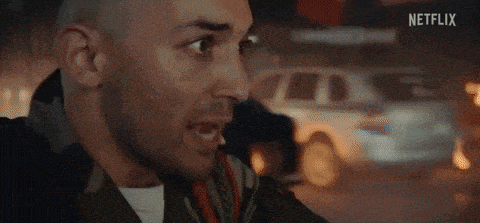
An explosive epic in more ways than one, Romain Gavras’s Netflix feature Athena is set in France in 2022 but draws on the tradition of Greek tragedy. It starts with a clamoring desire for revenge that ignites the titular Parisian housing project into a riot in the opening scenes of the film and builds into a vicious — and highly visceral — battle between brothers, between social classes, and between the police and the populace.
Dali Benssalah (No Time to Die, Les Sauvages), plays Abdel, a career soldier committed to serving France and very dedicated to his job, in contrast to his younger brother Karim (first-time actor Sami Slimane), who leads the revolt, and the eldest brother Moktar, a self-interested drug dealer played by Ouassini Embarek (Café de la plage).
“It’s a fictional story about a brotherly love that can push you to do extreme things,” explains Slimane. “Athena is a subtle film. Familial love isn’t something that can be controlled. And there are different ways to deal with it, especially when you’ve been separated as a family, and for brothers raised without a father. In the film, we were going in three different directions. My character is the one who sees red and wants revenge at all costs. Abdel my brother is coming back from the army, he has seen death and wants to calm everything down. Our brother [Moktar] only thinks about himself and protecting his business. In this story, everyone is in the wrong, and everyone is in the right at the same time.”
“Athena is the story of a fragmented sibling who is a huge liability. I wanted to be able to project myself into all the characters” says Gavras. “The merchant who thinks only of his interests like Moktar, a brother who wants to stop the fire like Abdel, and finally the one who wants to burn everything down, like Karim.”
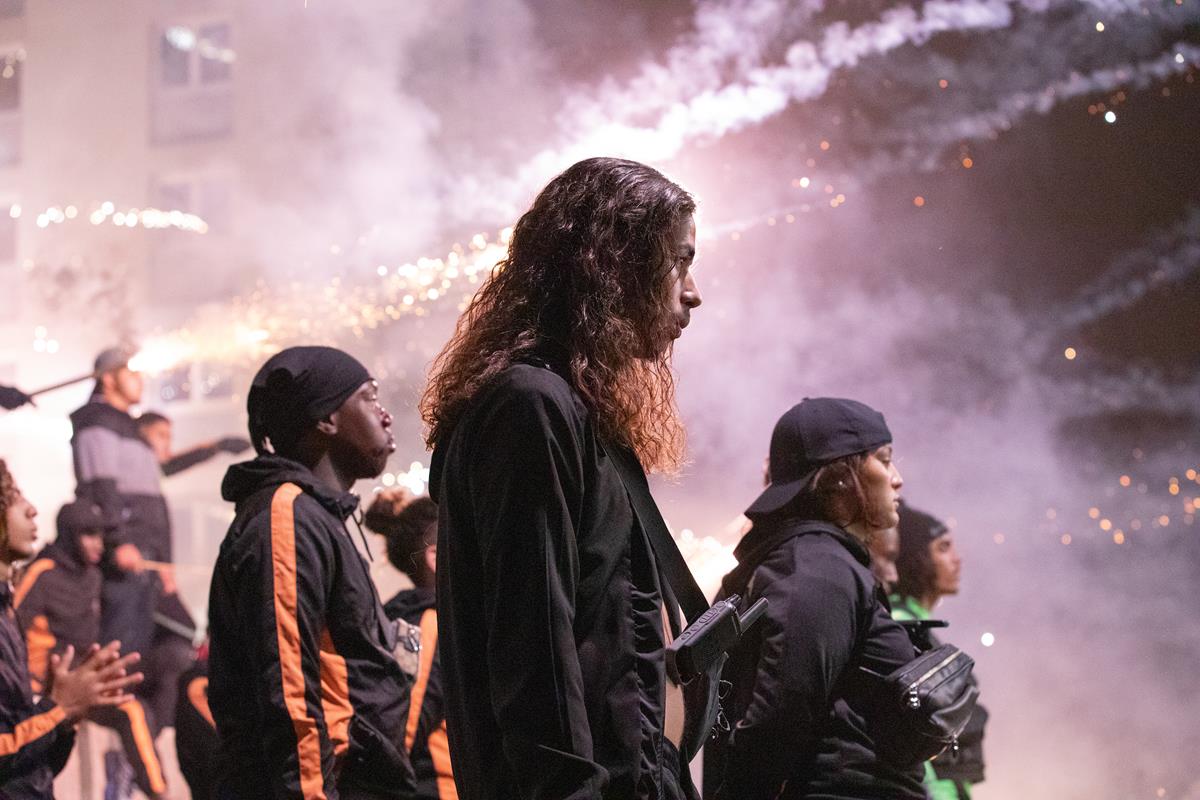
This relationship of brotherly discord is set against the backdrop of Athena, a highly-pressured conglomeration of frustration and people crammed behind what often resembles fortifications — scenes in the trailer look like the siege of Troy. This was a deliberate move on the part of the filmmakers.
According to production designer Arnaud Roth, the production team researched housing projects in France that were going to be under construction, demolished, or destroyed.
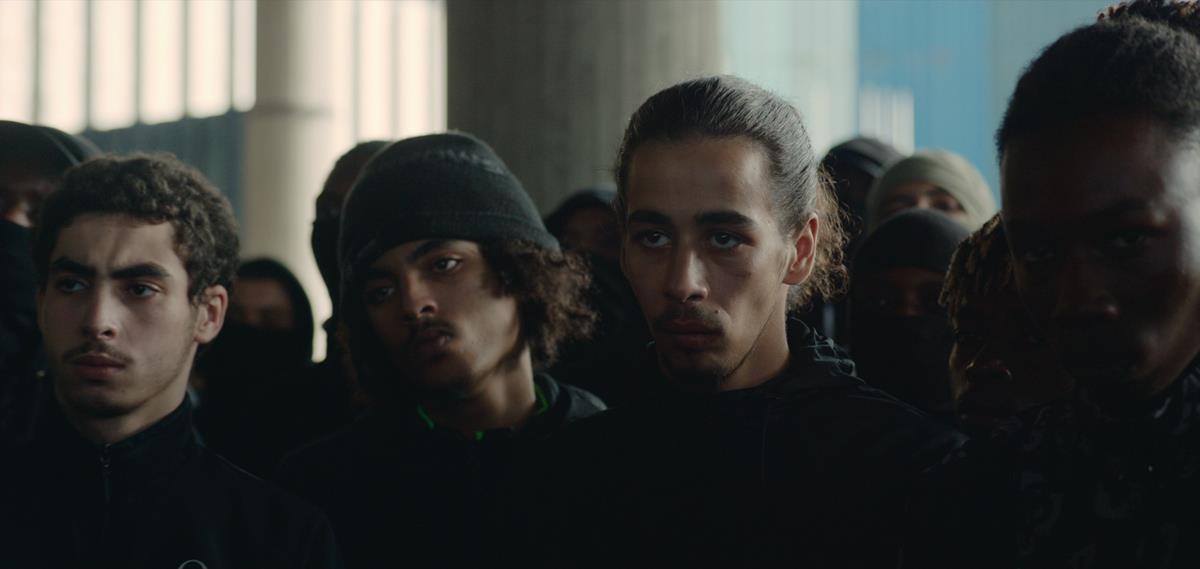
The Parc aux lièvres housing project in the Évry-Courcouronnes banlieue, or suburb, of Paris, “was probably the only one that, given its geography and its structure, reminded us of a fortress,” recalls Roth. “The architecture seduced us; the further we went in, the more it became an obvious choice.
“We quickly reached an agreement with Romain Gavras and Matias Boucard, the cinematographer, that the success of the movie would depend on ‘invisible’ decoration,” Roth continues. “There were a certain number of feelings that we wanted to generate, starting with isolation. In order to emphasize this ‘fortress’ and siege element, we closed the esplanade. We created walls in places where there weren’t any, crenelations that we particularly see during the riot police attack. In that way, we accurately and subtly conveyed our messages and responses.”
Run and Gun
The opening dozen minutes of the film consist of a mind-blowing single take: “a tour de force that lands with the impact of a shotgun blast to the chest,” says Nick Schager in his review for The Daily Beast.
“Gavras pans across the throngs of journalists to fixate on Abdel’s live-wire sibling Karim, who tosses a Molotov cocktail into the police station and, in doing so, lights the fuse of a city primed to detonate,” Schager reports. “Detonate it most certainly does, and Athena immediately dives headfirst into the resultant pandemonium… [the] camera bobs and weaves, paces and races, glides and soars with a dexterity that’s nothing short of astonishing. Entering, exiting and crossing physical spaces with seemingly impossible fluidity, it’s an introductory salvo of ingenuity and urgency.”
READ MORE: Netflix’s ‘Athena’ Has One of the Best Opening Sequences in Movie History (The Daily Beast)
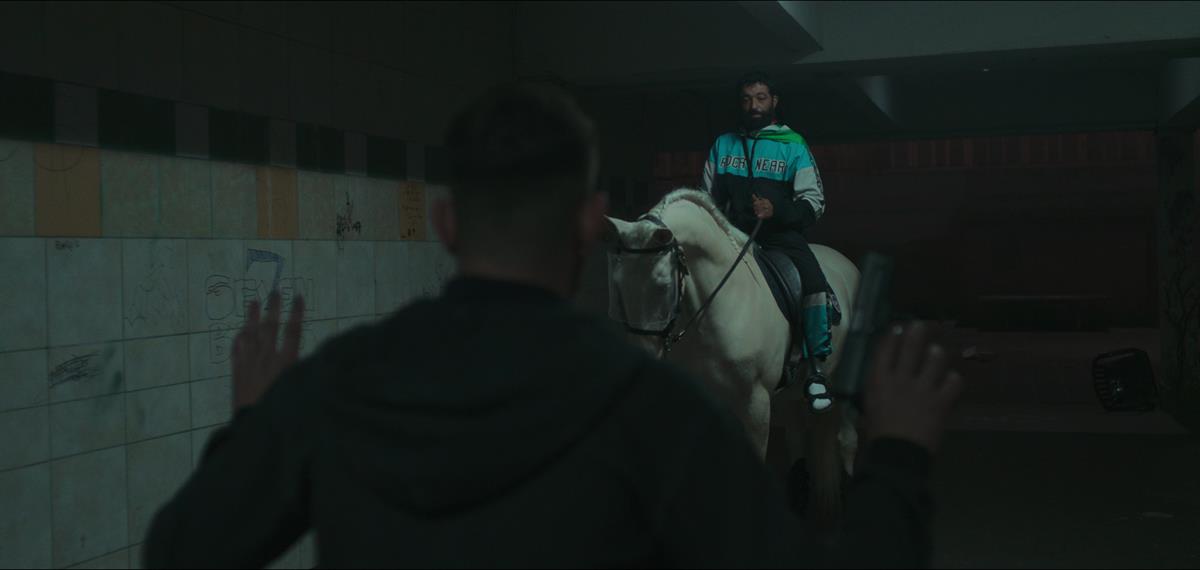
“The one-take is an oft-overused gimmick, but Gavras and cinematographer Matias Boucard create such dynamism with their swooping, chasing camera, it’s hard to believe the acrobatics in the frame remain so coherent and exciting,” says John Bleasdale in a review for the BFI’s Sight and Sound. “Gavras knows when to cut and when to allow a moment to breathe. Some of his images — with fireworks fired at the police and teargas engulfing the scene — are sublimely, disturbingly beautiful: Delacroix for the Snapchat age. GENER8ION’s soundtrack, when it barges through the sound of explosions, escalates the tension further.”
READ MORE: Athena: Delacroix for the Snapchat age (Sight and Sound)
Rolling Stone’s David Fear says this first sequence is key to everything that the Franco-Greek filmmaker is trying to accomplish.
“It’s spectacular and quite a feat, for sure. More importantly, it immerses you in the action, gives you an incredible sense of place and an even better sense of the stakes, and by letting it unfold in real time, reminds you how it just takes a spark or two to quickly turn into an inferno,” says Fear. “A colleague has referred to this as ‘Fury Road in the Hood’ and given the woozy mix of adrenaline rush and white-hot social commentary that the film traffics in, the comparison tracks. Athena does not want to inspire an uprising. It is an uprising.”
READ MORE: ‘Athena’ Doesn’t Want to Start an Uprising — It *Is* an Uprising (Rolling Stone)
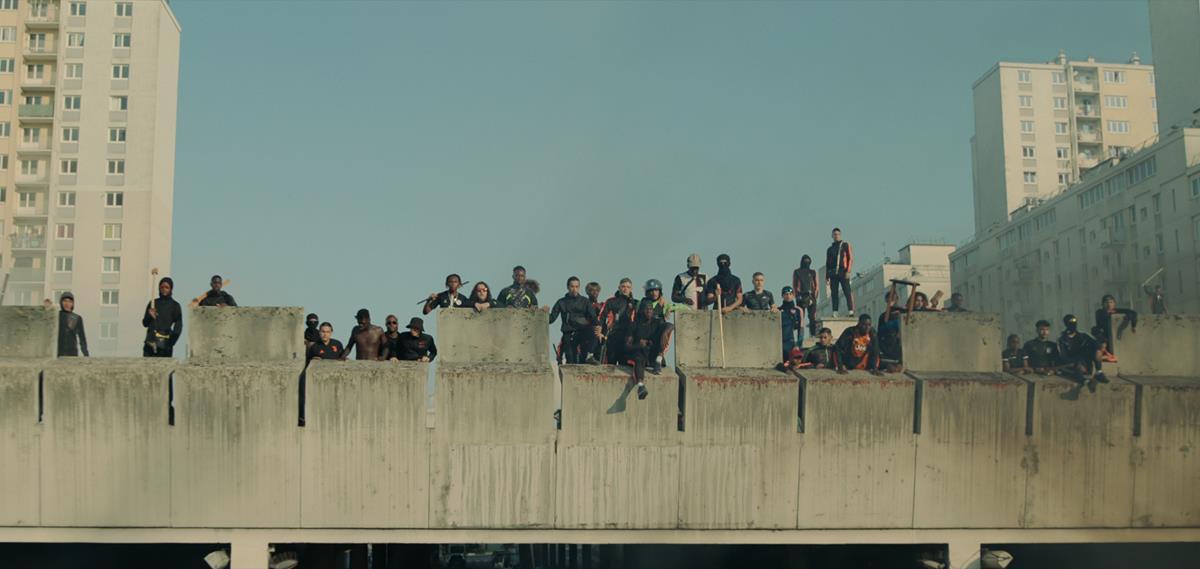
“It’s a very immersive film,” Gavras agrees. “These first few minutes represent above all a desire to stage all the grandeur of an ancient tragedy… but in a contemporary setting. They serve as a starting point for this opera in the ‘somewhat disadvantaged’ projects, which could just as easily be set in many places around the world. “Athena is a film which, like a certain kind of reality, remains quite violent, and this choice was crucial, to show how a display of violence, justified or not, is merely a means to a greater end.”
Tragic Staging
You’ll notice that Gavras (Our Day Will Come, The World Is Yours) refers to his third film as an opera — indeed it has a choral accompaniment in the form of the chants of the rioters/defenders. He sees it as a “choreographed piece that moves rapidly toward chaos, with neither villains nor good guys, but a chorus of characters heading inexorably toward tragedy, driven by their destiny and the trap that has been set for them.”
“We called it Athena just because we wanted to pull the thread of Greek tragedy, and of course, Athena is the goddess of war and wisdom,” Gavras tells Patrick Brzeski at The Hollywood Reporter. “It’s not a real neighborhood, and it’s not based on a real story. It was based on a lot of stories. This riot hasn’t happened yet, but it’s almost like it’s the riot that could happen.
“There’s a lot of tension everywhere in the world… and we feel like everyone’s kind of pushing towards that,” Gavras continues. “And we know from history that civil wars are the worst thing that can happen to society. It’s something that men in my family have known — it’s like grandfather against grandfather; cousin against cousin. It’s the worst because it’s within the family. This is why we took the intimacy of a family getting torn apart, where their torment spills across the neighborhood and then across the country.”
READ MORE: Venice: Romain Gavras on Creating the “Greek Tragedy” of His “Immersive” Epic ‘Athena’ (The Hollywood Reporter)
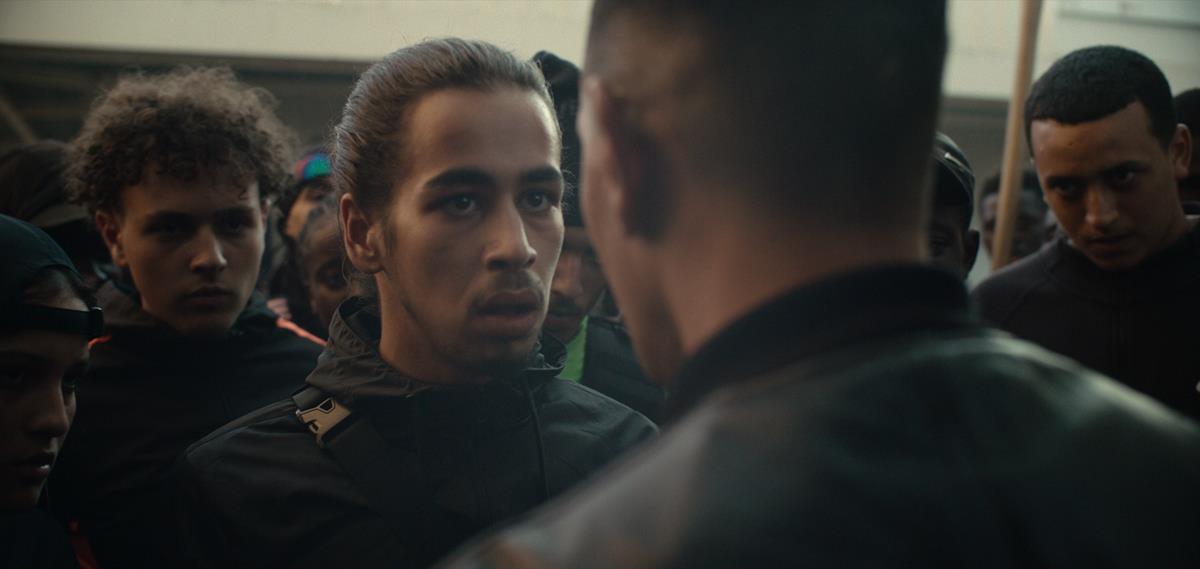
The Camera at War
“This is not just a skirmish. Athena is fully a war movie recognized by both the filmmakers and the characters,” The Playlist’s Marshall Shaffer tells us. “With time and the intensification of the battle, the merits of Gavras’ scenario-first approach emerge. He does not need to establish character as the nature of war inevitably reveals it. Each brother’s response to the dizzying pace of events unfolding proves a source of endless fascination within Athena. These men cannot just be easy stand-ins for ideologies. To fit in with the feel of the film, they must be flesh-and-blood people who respond unpredictably and erratically to battlefield happenings.”
READ MORE: ‘Athena’ Review: Romain Gavras’ Police Brutality Thriller Is Positively Electrifying (The Playlist)
Fittingly, Gavras draws on cinematic themes of warfare and siege, with influences such as Kurosawa’s Ran, Coppola’s Apocalypse Now, and Gladiator, directed by Ridley Scott. The epic scale of these films is mirrored in the use of IMAX format for Athena, with cinematographer Matias Boucard shooting on the “last available IMAX at that time in the world.”
“IMAX is for large spaces and using it enabled us to get out of that projects, hip-hop, urban side of the movie,” recalls Boucard. “The camera is admittedly heavy, but it brings space and life to the footage.
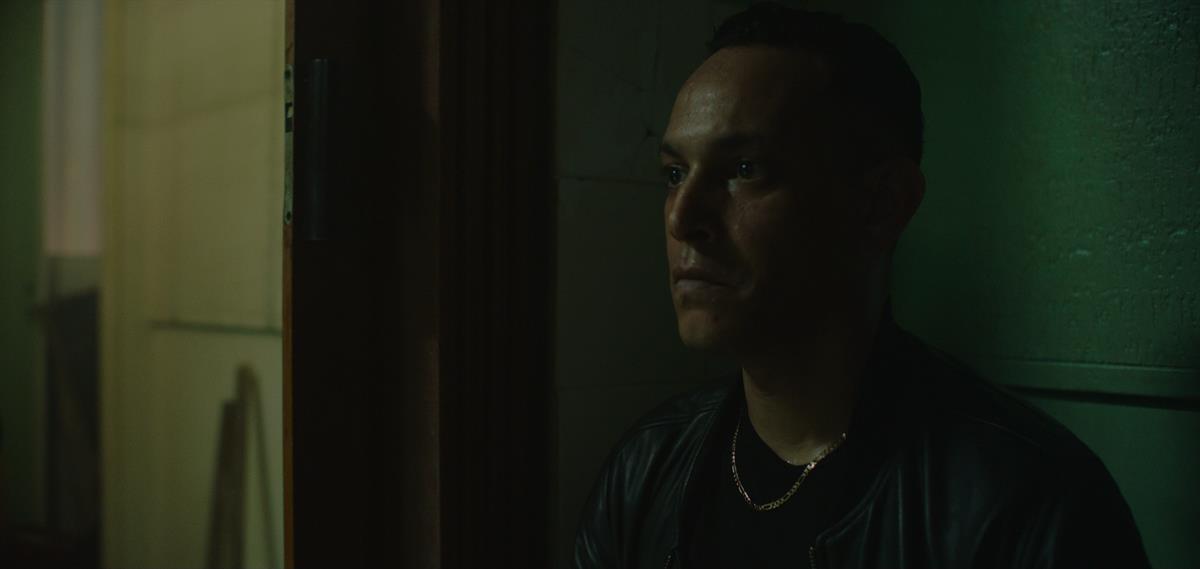
“The camera really helped us to make both simple and dramatic movements at the same time. We shot it like a movie that could have been made 30 years ago and which will be able to be made in 50 years. The riot police attack scene illustrates this wonderfully: we brought the biggest crane in Europe from the Czech Republic; it was more than 35 meters tall. Then we put it on a lorry that normally transported giant combine-harvesters and drove it in reverse in the middle of 250 extras! If we’ve gone to all this trouble, it’s to create a type of timelessness.”
The New Yorker’s Richard Brody points out that Gavras also had drones at his disposal. “They enable the camera to zip through space in ways that dazzle — for an instant — until continued use of the obvious technique yields merely a shrug,” he says. “Gavras’s elaborate methods in Athena — which involve the grand staging of interconnected events with a huge cast over large spaces — attempt to unite the panoramic and the intimate, the personal and the public, in ways that don’t do any of these elements justice.”
READ MORE: Athena Reviewed: When Social Thought Becomes Hectic Spectacle (The New Yorker)

Vulture’s Bilge Ebiri examines how Boucard’s camera work was essential to understanding the characters and storyline in what he calls “the year’s wildest movie opening.”
In the first few shots of the pivotal car crash sequence, “as Abdel asks for calm, the camera pans to the crowd watching him, then moves toward Karim (Sami Slimane), Abdel’s younger brother.” Ebiri notes how “it was crucial that the audience’s attention be immediately drawn to Karim. Thus, when the camera glides from Abdel to his brother, the focus changes immediately to ensure that our eyes land on Karim, even though at that point he’s just another face in the crowd.”
The camera makes both the physical and emotional distance between the two brothers immediately apparent. “We go from one brother to the other, but we also needed the distance between them,” Boucard explained to Ebiri.
Each character, as Ebiri observes, is shot differently. “The camera focuses intently on Karim whenever he’s onscreen and tracks smoothly along with him, conveying his total control over his surroundings,” he writes. “For Abdel, however, who is desperate to quell the uprising and talk sense into his brother, the camera is far less steady, often roaming around him as if replicating his anxiety and confusion.”

Gavras acknowledges that “an extremely long, unbroken sequence that moves from location to location and plunges in and out of scenes of crazy violence is rarely filmed as one actual shot but rather stitched together out of shorter elements,” as Ebiri points out, but “a magician’s not going to tell his tricks,” he says.
Still, “such cuts tend to come during fast pans or instances when a large figure (such as a passing actor or a column) briefly enters the frame and obscures some of the action,” Ebiri theorizes. “Often the deception is required for safety.”
This is why the car ramming into the station doors was ultimately achieved in layers, as Boucard explained. “The camera movement was perfectly repeated first with the actors, then with the car, and the two resulting shots placed on top of each other during editing,” Ebiri summarizes. “The effect works so well because it’s a slightly blurry background action and doesn’t draw attention to itself — we’re still watching the actors.”
READ MORE: A Hell of an Introduction How director Romain Gavras and his cast and crew created the year’s wildest movie opening. (Vulture)
In an interview with Sam Moore at The Quierus, Gavras gives more insight to the explosive opening sequence: “There’s no CGI in the film, the crowd is real, the fireworks are real, everything is done mechanically,” he says. “For example, in that scene, we go from outside the van with the camera on the motorcycle, passing it inside the van, so the idea was to do everything very practically.”
Visually, Gavras says, his work is inspired by things “from paintings to Kurosawa to Apocalypse Now. What I liked in Apocalypse Now is that it is about the Vietnam War but it’s bigger than just Vietnam, Coppola made it timeless and we had a lot of references to that,” he says. “Back in the day they did it with cranes, and we wanted to make it like this with no green screen.”
READ MORE: High Alert: Romain Gavras On Greek Tragedy Athena (The Quietus)
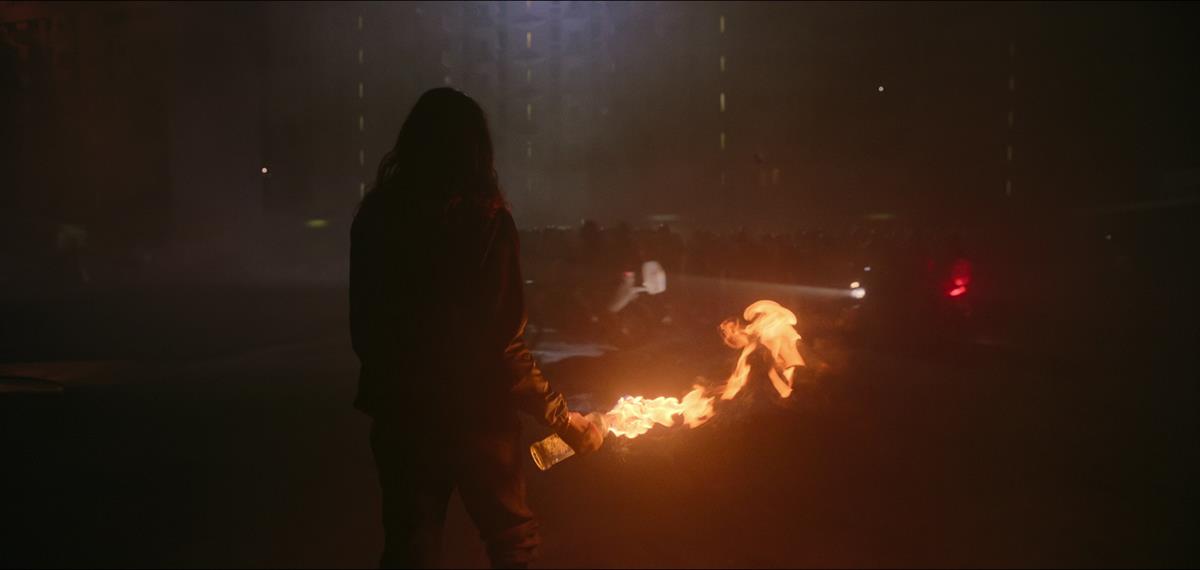
But without the use of CGI or green screen, how did the filmmakers choreograph the violence and chaos of the film’s opening sequence, which appears to unspool in a single unbroken shot?
Speaking with CNN’s Thomas Page, Gavras explained, “We rehearsed the whole film for almost two months, like you’d rehearse a play or an opera, with a small camera, the main actors pretending there were fireworks and extras around them, to see the dance between the camera and the actors and the rhythm… The planning, weirdly, was almost military and very precise to create chaos in front of the camera.”
As a safety measure, Netflix provided additional security on set during production, Gavras recounts, “a team making sure we were not doing insane stuff,” as he puts it. “First, they want you to shoot everything green screen because it’s the way people do it, but I feel you lose a lot when you do this,” he says. “My 13-year-old daughter, she sees CGI everywhere, she’s like, ‘fake fire,’ ‘green screen.’ It’s not precise but it’s a feeling you have. And I don’t think you have it in this film.”
Gavras had decided to build Athena around a series of long takes “quite early on,” he told Page. “Tragedy starts with sunup and finishes with sunup. Twenty-four hours for a film is almost a real-time experience. We wanted to be within that real-time experience. Those long takes do that because you don’t jump in time.”
READ MORE: Romain Gavras on his ferocious drama ‘Athena’: ‘I don’t think films can change the world’ (CNN)
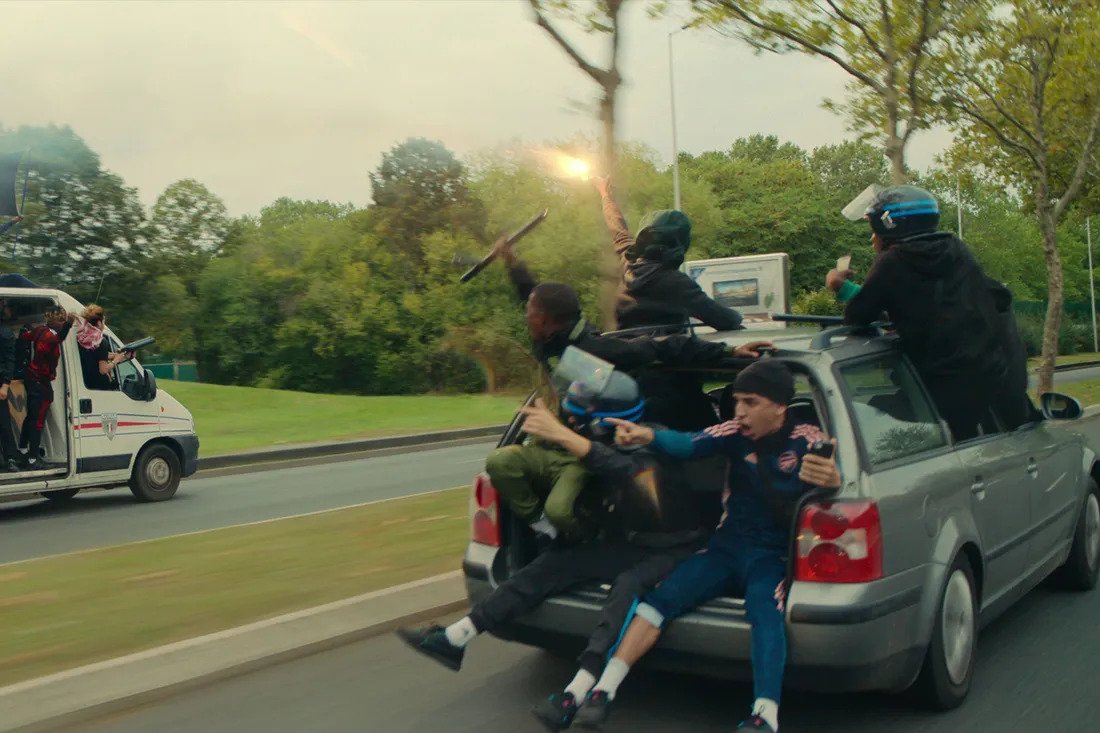
But without the use of CGI or green screen, how did the filmmakers choreograph the violence and chaos of the film’s opening sequence, which appears to unspool in a single unbroken shot?
Speaking with CNN’s Thomas Page, Gavras explained, “We rehearsed the whole film for almost two months, like you’d rehearse a play or an opera, with a small camera, the main actors pretending there were fireworks and extras around them, to see the dance between the camera and the actors and the rhythm… The planning, weirdly, was almost military and very precise to create chaos in front of the camera.”
As a safety measure, Netflix provided additional security on set during production, Gavras recounts, “a team making sure we were not doing insane stuff,” as he puts it. “First, they want you to shoot everything green screen because it’s the way people do it, but I feel you lose a lot when you do this,” he says. “My 13-year-old daughter, she sees CGI everywhere, she’s like, ‘fake fire,’ ‘green screen.’ It’s not precise but it’s a feeling you have. And I don’t think you have it in this film.”
Gavras had decided to build Athena around a series of long takes “quite early on,” he told Page. “Tragedy starts with sunup and finishes with sunup. Twenty-four hours for a film is almost a real-time experience. We wanted to be within that real-time experience. Those long takes do that because you don’t jump in time.”
READ MORE: Romain Gavras on his ferocious drama ‘Athena’: ‘I don’t think films can change the world’ (CNN)
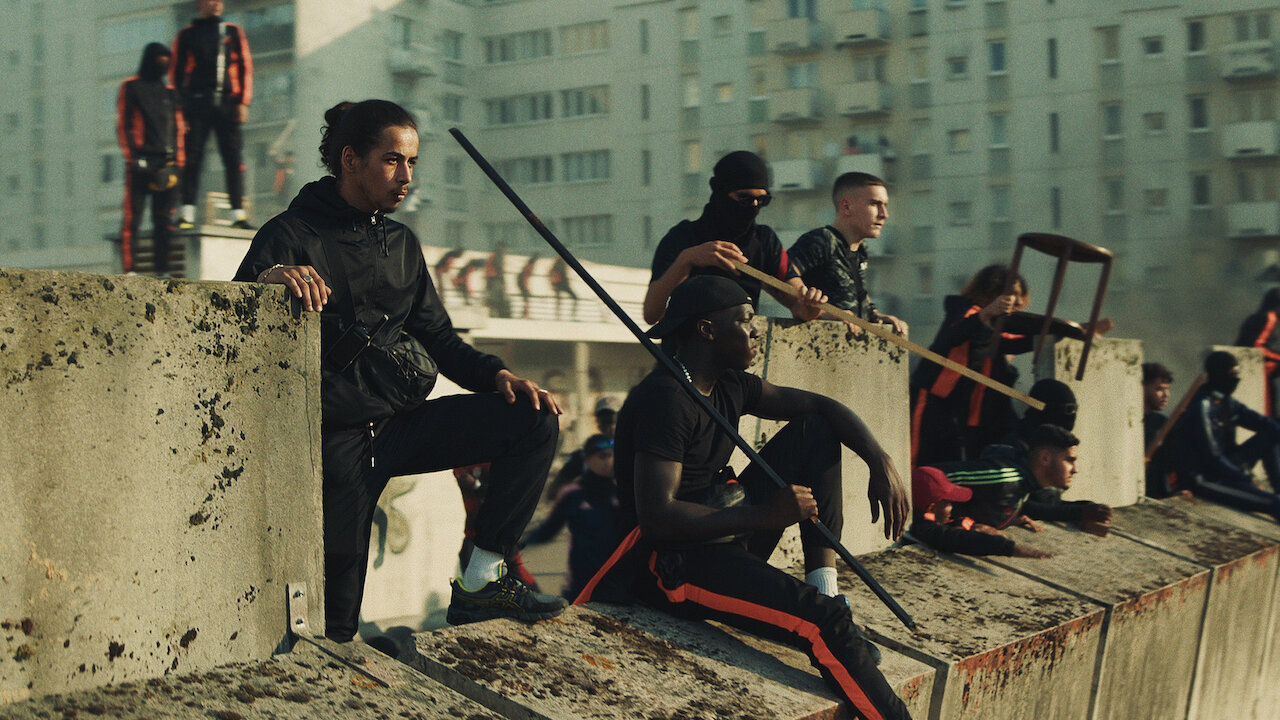
Collaborative Effort
Gavras tells Elena Lazic at Cineuropa that writing the film with Ladj Ly (Les Misérables, 2019) and Elias Belkeddar was a very smooth process. “We all really got into it during the first few months of COVID,” recalls Gavras. “Strangely, when you think the world is going to end or you don’t know what will happen, you can write a very ambitious film like that because you tell yourself that it might never get made, and you’ll never really have to shoot all of these one-take sequences. It’s easy to write, on paper, ‘We start there, and we end there.’ We wrote it without the constraint of feasibility — except that later, the feature was greenlit, and we had to shoot it. I had fewer white hairs before this film.”
Gavras is clear that without Netflix the movie would not have been made. “I must say that the collaboration was quite extraordinary, in the sense that they let me make the film that I wanted, which would not necessarily have been the case with a traditional producer,” he tells Lazic. “But obviously, as a director, I want people to see it on the big screen, which the media timeline in France does not allow. It’s a system that I think needs to change. But the film will exist on the big screen: it will do a week in New York, a week in London. It is also a picture that actually works well on TV, and there’s also the pleasure of knowing that the whole world will be able to see it on the same day. There are pros and there are cons, but the reality is that I couldn’t have made this movie without Netflix.”
READ MORE: Romain Gavras, Director of Athena (Cineuropa)
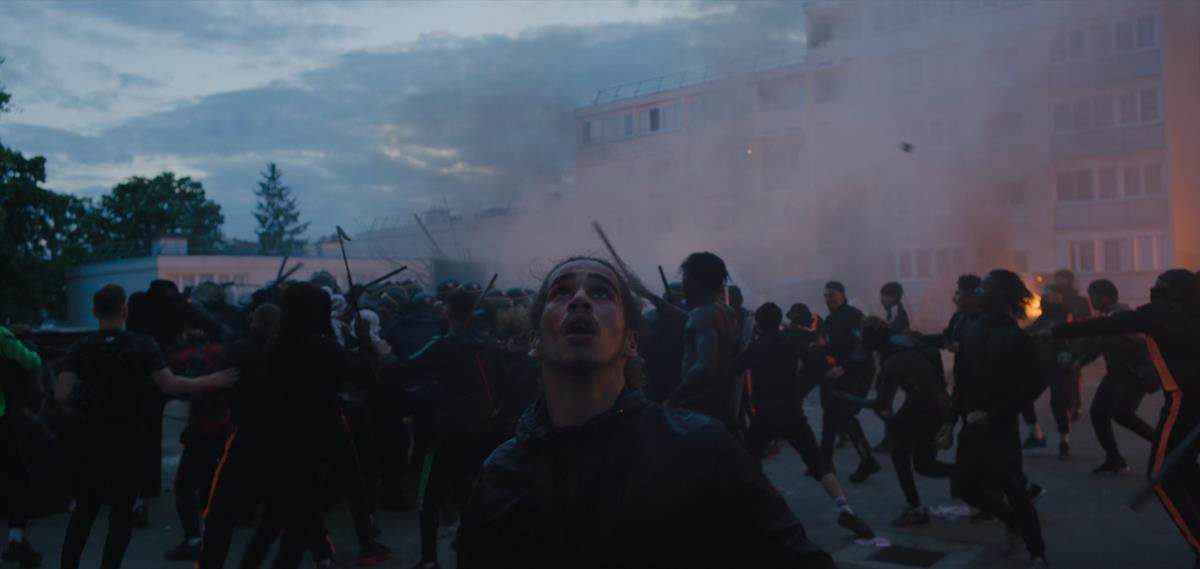
With Athena, Gavras and his co-writers wanted to create “a spark that will set the nation ablaze first-hand, starting with the personal story of a sibling whose pain and violence will spill over into the projects, and off-screen on the country.
“Very quickly, we wanted to elevate the form of the story, not treat it as a documentary or a social reality, but to make this story feel timeless and symbolic through the use of images,” he adds. “Athena could have taken place at any time in the past or the future. Behind every war hides a manipulation; an original lie. History repeats itself, from the Trojan War to contemporary wars. There are always forces in the shadows that feed the conflict.”
Get Ready for the Experiential Vibe of Alejandro G. Iñárritu’s Immersive and Visually Stunning “Bardo”
By Jennifer Wolfe
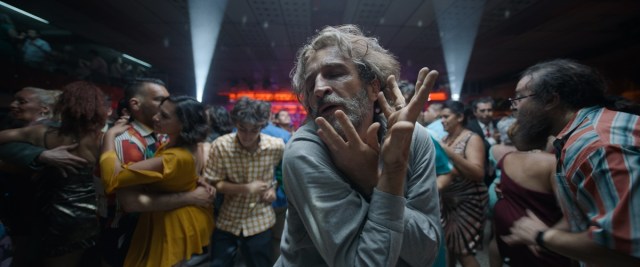
Much like the explosive, immersive experientiality Romain Gavras’s Athena provides, Bardo, False Chronicle of a Handful of Truths is a visually stunning and immersive experiential epic from the master of some of cinema’s most immersive and experiential films himself, Alejandro G. Iñárritu (Babel, Birdman, Biutiful, The Revenant).
The latest project from the multi-Academy Award-winning director, Bardo will debut on Netflix on December 16, preceded by a theatrical release in Mexico on October 27 before rolling out for global expansion on November 18. Written by Iñárritu and Nicolás Giacobone (Birdman, Biutiful) and shot on glorious 65mm film by Oscar-nominated cinematographer Darius Khondji (Amour, Se7en), the film features production design by Oscar-winning Mexican designer Eugenio Caballero (ROMA, Pan’s Labyrinth) and costume design by Anna Terrazas (The Deuce, ROMA).
Bardo follows the intimate and moving journey of Silverio Gama (Daniel Giménez Cacho), a renowned Mexican journalist and documentary filmmaker living in Los Angeles. After being named the recipient of a prestigious international award, Silverio is compelled to return to his native country unaware that this simple trip will push him to an existential limit. Along the way, he faces universal questions about identity, success, and morality, as well as the history of Mexico and the bonds he shares with his family.
In the film’s production notes, Iñárritu shares his inspiration for the project. “My family and I left Mexico City and came to California 21 years ago. Leaving your country behind comes with hopes and plans for the future but inevitably also with uncertainty, contradictions, and paradoxes.”
Bardo will be Iñárritu’s first film shot in his native Mexico since 2000’s Amores Perros. “Mexico, more than a country, is a state of mind,” the director says. “Actually, every home country is; a place where lots of stories and narratives are being endlessly told that strengthen our identity and sense of belonging while giving us collective power.”
What happens when we spend time away from this home then? “Memory lacks truth. It only possesses emotional conviction.”
Iñárritu references the Buddhism state of bardo — “the space between. A place where things die, come to life again, and are transformed into a state of perpetual uncertainty… [Silverio] eventually realizes that reality is pure fiction, so it is through fiction that he attempts to find the truth.”
But, as Iñárritu warns, he hasn’t found any absolute truths. “Only a journey between reality and imagination. A dream. Dreams do not possess time. Neither does cinema. Dreams, as cinema, are real but not truthful. In both, time is liquid. Bardo is the chronicle of the journey I went through between those two illusions whose borders are indecipherable for me.”
LIGHTS, CAMERA, ACTION! SPOTLIGHT ON FILM PRODUCTION:
From the latest advances in virtual production to shooting the perfect oner, filmmakers are continuing to push creative boundaries. Packed with insights from top talents, go behind the scenes of feature film production with these hand-curated articles from the NAB Amplify archives:
- “Decision To Leave:” Park Chan-wook’s Love Story/Detective Story
- Fantastic Fantasía: Making Alejandro González Iñárritu’s “Bardo”
- “The Banshees of Inisherin:“ Martin McDonagh Tells a Wonderful/Terrible Tale
- Control and Chaos: Todd Field on “Tár”
- Family Pictures: James Gray’s “Armageddon Time”
- She Stoops to Conquer: Gina Prince-Bythewood Goes to War for “The Woman King”
- The Revolution Will Be Televised: Making the Immersive, Explosive “Athena”

